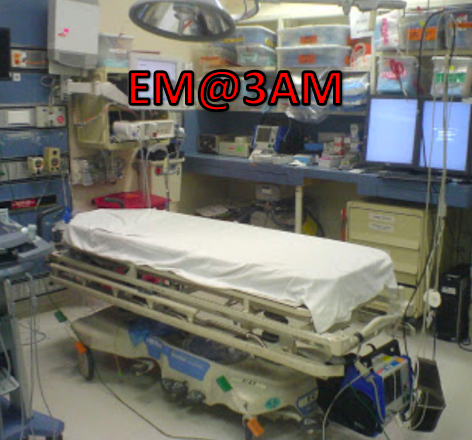Author: Erica Simon, DO, MHA (@E_M_Simon, EM Chief Resident, SAUSHEC, USAF) // Edited by: Alex Koyfman, MD (@EMHighAK, EM Attending Physician, UT Southwestern Medical Center / Parkland Memorial Hospital) and Brit Long, MD (@long_brit, EM Attending Physician, SAUSHEC, USAF)
Welcome to EM@3AM, an emdocs series designed to foster your working knowledge by providing an expedited review of clinical basics. We’ll keep it short, while you keep that EM brain sharp.
A 67-year-old female presents by EMS for altered mental status. Per her daughter, the patient became increasingly lethargic in the hours prior to arrival. Review of systems, obtained from the patient’s care nurse, was significant for right-sided abdominal pain of four days duration – a common complaint as the patient’s previous history was significant for common bile duct stenting secondary to pancreatic malignancy.
On inspection the patient is altered (GCS 11), but protecting her airway. She has scleral icterus and jaundice (worsened per family). The patient grimaces on palpation of the right upper quadrant.
Initial VS: BP 90/68, HR 147, T 103.2 Rectal, RR 24, SpO2 95% on room air.
What’s the next step in your evaluation and treatment?
Answer: Ascending Cholangitis1,2
- Definition: Biliary tract infection resulting from bile duct obstruction (secondary to choledocholithiasis, malignancy, biliary tract stricture, primary sclerosing cholangitis, AIDS cholangiopathy, etc).
- Epidemiology: Reportedly occurs in 50,000-75,000 individuals in the U.S. annually; mortality estimated as 5%.1
- Presentation: Fever is the most common presenting symptom (90% of cases1). Charcot’s triad (fever, right upper quadrant pain, and jaundice) is present in 56-70% of patients.1 Individuals with ascending cholangitis frequently report mild abdominal pain and nausea.
- Charcot’s triad + hemodynamic instability and altered mental status = Reynold’s pentad (5-7% of patients with ascending cholangitis; associated with significant morbidity and mortality1).
- Evaluation and Treatment:
- Perform a thorough H&P:
- History of gallstones, biliary colic, or pancreatitis => mechanical biliary obstruction
- History of back pain, weight loss, acholic stools => pancreatic or biliary malignancy
- History of biliary reconstruction or endoscopic biliary duct manipulation => stricture/indwelling stent occlusion
- Evaluation:
- Labs:
- LFTs: conjugated hyperbilirubinemia, transaminitis, elevated alkaline phosphatase, elevated GGT
- CBC: leukocytosis with a neutrophil predominance common in immunocompetent patients
- Imaging:
- Ultrasound: First-line =>capable of detecting CBD dilatation and gallstones1
- CT: Not sensitive for the diagnosis of choledocolithiasis; commonly utilized to evaluate co-existing pathology (hepatic/pancreatic mass, etc.)
- Labs:
- Treatment:
- Initiate antibiotic therapy directed towards enteric gram-negative and gram-positive aerobes and anaerobes:
- Fluoroquinolones, extended-spectrum penicillins, carbapenems, and aminoglycosides => all achieve high biliary concentrations
- Patients with indwelling stents, prior biliary-enteric surgery, or the immunocompromised: initiate antifungal therapy in addition to antibiotics
- Consult surgery / GI for biliary decompression => ERCP is the procedure of choice (effective in 90% of cases).1 Timing of biliary decompression is variable:
- Severe cases (patients presenting with sepsis/septic shock or developing SIRS/sepsis after 12-24 hours of antibiotics = emergent decompression
- Patients clinically improving s/p antibiotics and fluid resuscitation = decompression scheduled prior to hospital discharge2
- Initiate antibiotic therapy directed towards enteric gram-negative and gram-positive aerobes and anaerobes:
- Perform a thorough H&P:
- Pearls:
- Severe abdominal pain is uncommon in the setting of ascending cholangitis => consider pancreatitis, cholecystitis, or perforated viscus as alternative etiologies.
- Elderly patients, individuals with renal failure, co-existent liver abscess, or malignancy frequently have a poor outcome.
- In patients without a medical history of biliary pathology, malignancy, autoimmune disorder, or immunosuppression (AIDS), question specifically regarding travel to China, Japan, Taiwan, Vietnam or Korea => infection by Clonorchis sinesis and Opisthorchis (liver flukes) is known to cause ascending cholangitis.
- Adult flukes may remain alive in the bile duct for > 20 years.
References:
- Wolf P, Park J. Acute Ascending Cholangitis and Supporative Cholangitis. In Netter’s Infectious Disease. Philadelphia, Saunders. 2012; 43: 245-250.
- Tan W, Shelta V, Diddapur R. Oriental liver fluke infestation presenting more than 50 years after immigration. Ann Acad Med Singapore. 2009; 38(8):735-736.
For Additional Reading:
Cholangitis: Pearls & Pitfalls
http://www.emdocs.net/cholangitis-pearls-pitfalls/
Cholangitis: Deadly Cause of Right Upper Quadrant Abdominal Pain
Cholangitis: Deadly Cause of Right Upper Quadrant Abdominal Pain






